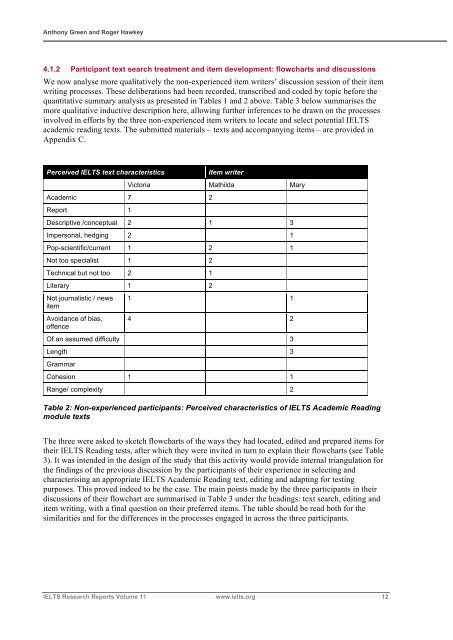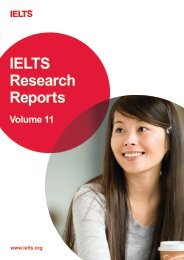An investigation of the process of writing IELTS Academic Reading ...
An investigation of the process of writing IELTS Academic Reading ...
An investigation of the process of writing IELTS Academic Reading ...
You also want an ePaper? Increase the reach of your titles
YUMPU automatically turns print PDFs into web optimized ePapers that Google loves.
<strong>An</strong>thony Green and Roger Hawkey<br />
4.1.2 Participant text search treatment and item development: flowcharts and discussions<br />
We now analyse more qualitatively <strong>the</strong> non-experienced item writers’ discussion session <strong>of</strong> <strong>the</strong>ir item<br />
<strong>writing</strong> <strong>process</strong>es. These deliberations had been recorded, transcribed and coded by topic before <strong>the</strong><br />
quantitative summary analysis as presented in Tables 1 and 2 above. Table 3 below summarises <strong>the</strong><br />
more qualitative inductive description here, allowing fur<strong>the</strong>r inferences to be drawn on <strong>the</strong> <strong>process</strong>es<br />
involved in efforts by <strong>the</strong> three non-experienced item writers to locate and select potential <strong>IELTS</strong><br />
academic reading texts. The submitted materials – texts and accompanying items – are provided in<br />
Appendix C.<br />
Perceived <strong>IELTS</strong> text characteristics<br />
Item writer<br />
Victoria Mathilda Mary<br />
<strong>Academic</strong> 7 2<br />
Report 1<br />
Descriptive /conceptual 2 1 3<br />
Impersonal, hedging 2 1<br />
Pop-scientific/current 1 2 1<br />
Not too specialist 1 2<br />
Technical but not too 2 1<br />
Literary 1 2<br />
Not journalistic / news<br />
item<br />
Avoidance <strong>of</strong> bias,<br />
<strong>of</strong>fence<br />
1 1<br />
4 2<br />
Of an assumed difficulty 3<br />
Length 3<br />
Grammar<br />
Cohesion 1 1<br />
Range/ complexity 2<br />
Table 2: Non-experienced participants: Perceived characteristics <strong>of</strong> <strong>IELTS</strong> <strong>Academic</strong> <strong>Reading</strong><br />
module texts<br />
The three were asked to sketch flowcharts <strong>of</strong> <strong>the</strong> ways <strong>the</strong>y had located, edited and prepared items for<br />
<strong>the</strong>ir <strong>IELTS</strong> <strong>Reading</strong> tests, after which <strong>the</strong>y were invited in turn to explain <strong>the</strong>ir flowcharts (see Table<br />
3). It was intended in <strong>the</strong> design <strong>of</strong> <strong>the</strong> study that this activity would provide internal triangulation for<br />
<strong>the</strong> findings <strong>of</strong> <strong>the</strong> previous discussion by <strong>the</strong> participants <strong>of</strong> <strong>the</strong>ir experience in selecting and<br />
characterising an appropriate <strong>IELTS</strong> <strong>Academic</strong> <strong>Reading</strong> text, editing and adapting for testing<br />
purposes. This proved indeed to be <strong>the</strong> case. The main points made by <strong>the</strong> three participants in <strong>the</strong>ir<br />
discussions <strong>of</strong> <strong>the</strong>ir flowchart are summarised in Table 3 under <strong>the</strong> headings: text search, editing and<br />
item <strong>writing</strong>, with a final question on <strong>the</strong>ir preferred items. The table should be read both for <strong>the</strong><br />
similarities and for <strong>the</strong> differences in <strong>the</strong> <strong>process</strong>es engaged in across <strong>the</strong> three participants.<br />
<strong>IELTS</strong> Research Reports Volume 11 www.ielts.org 12

















